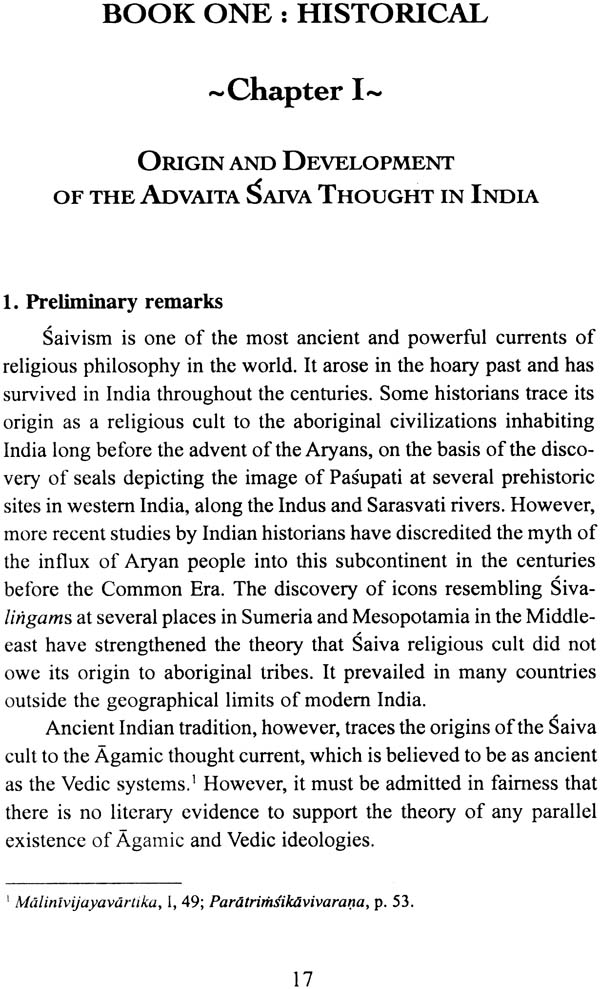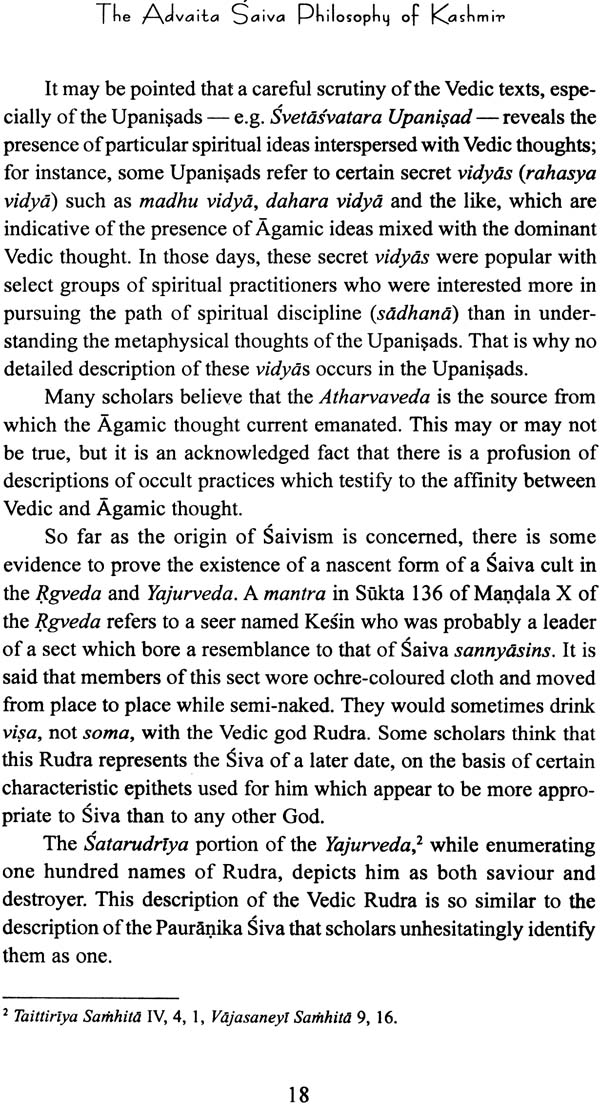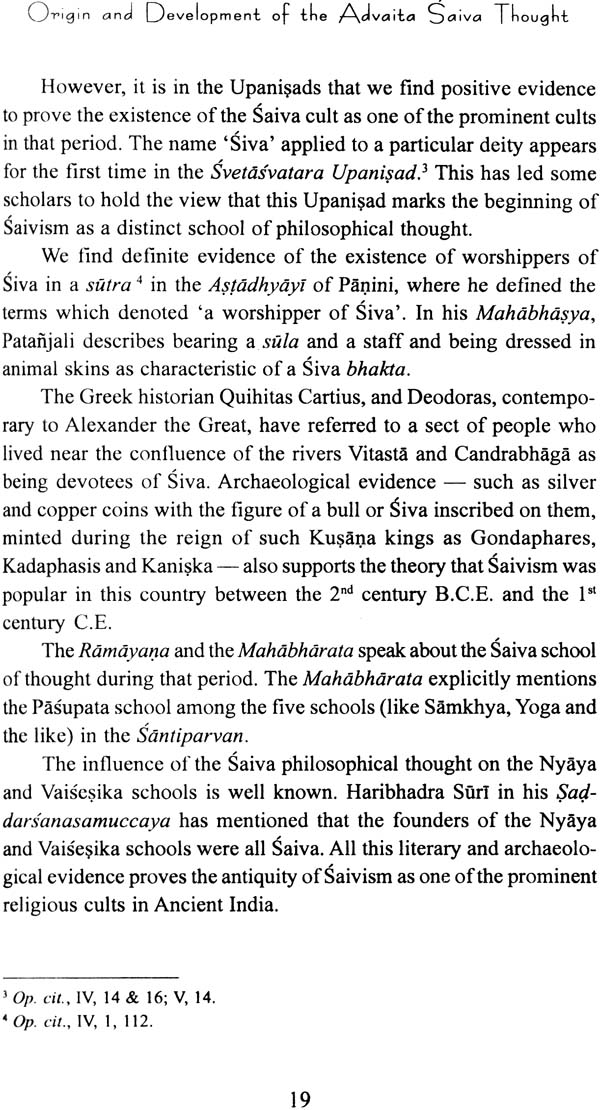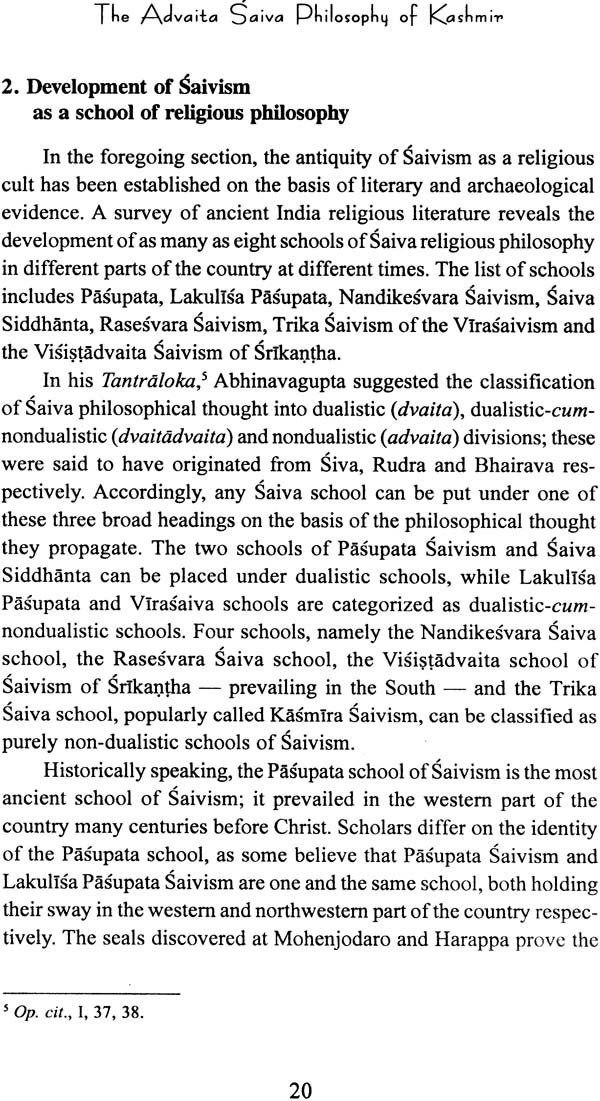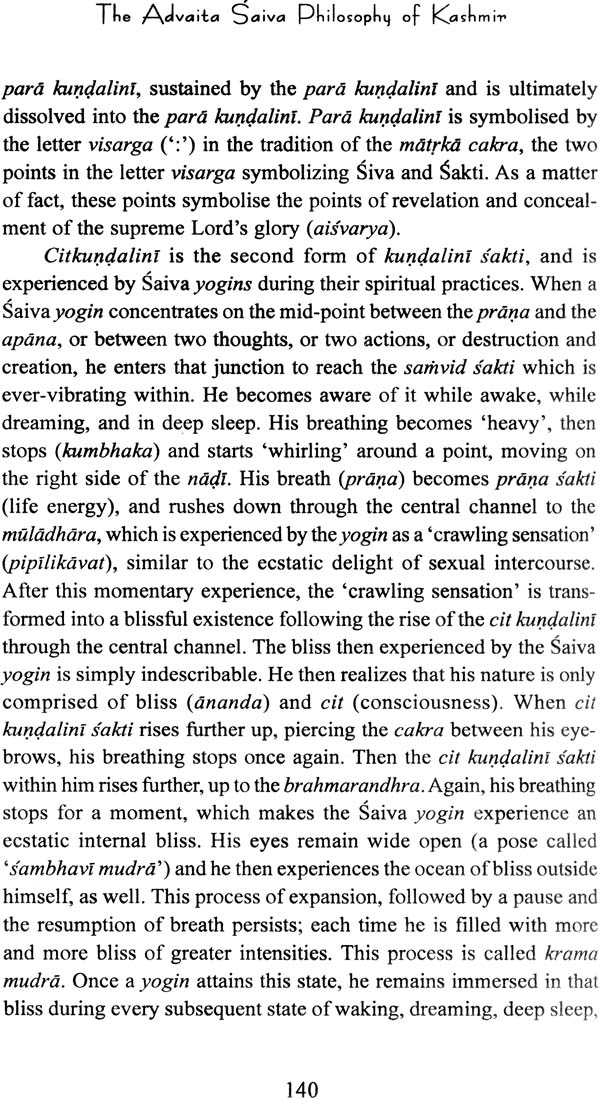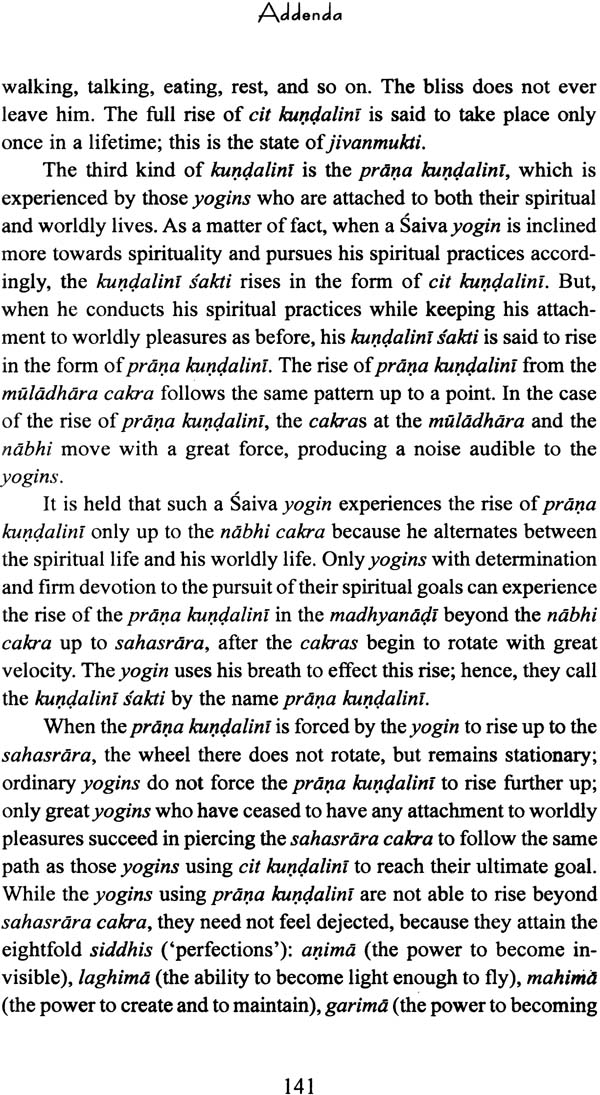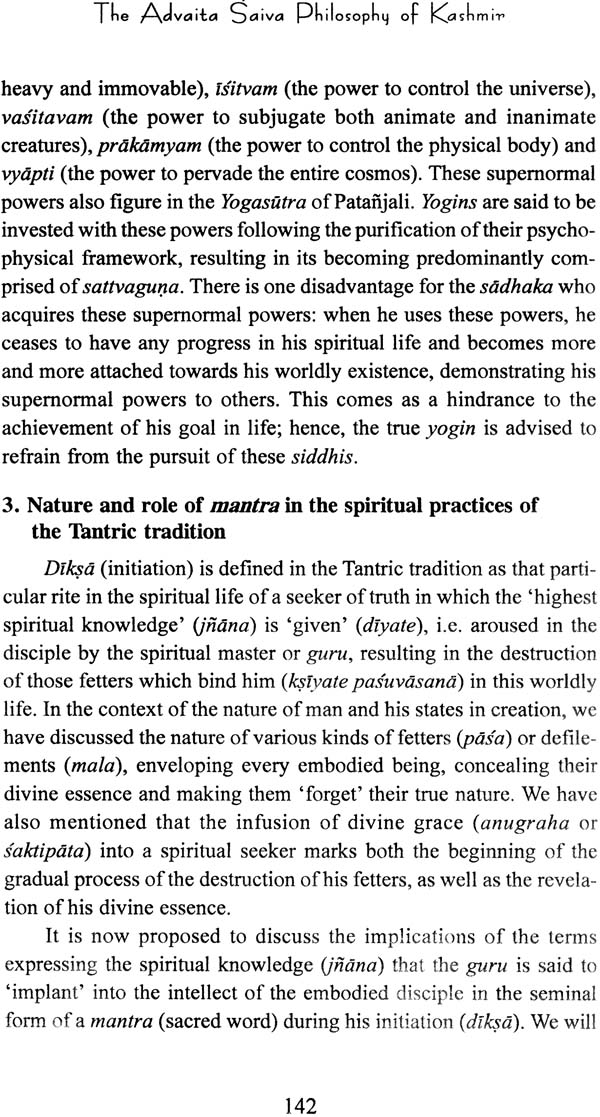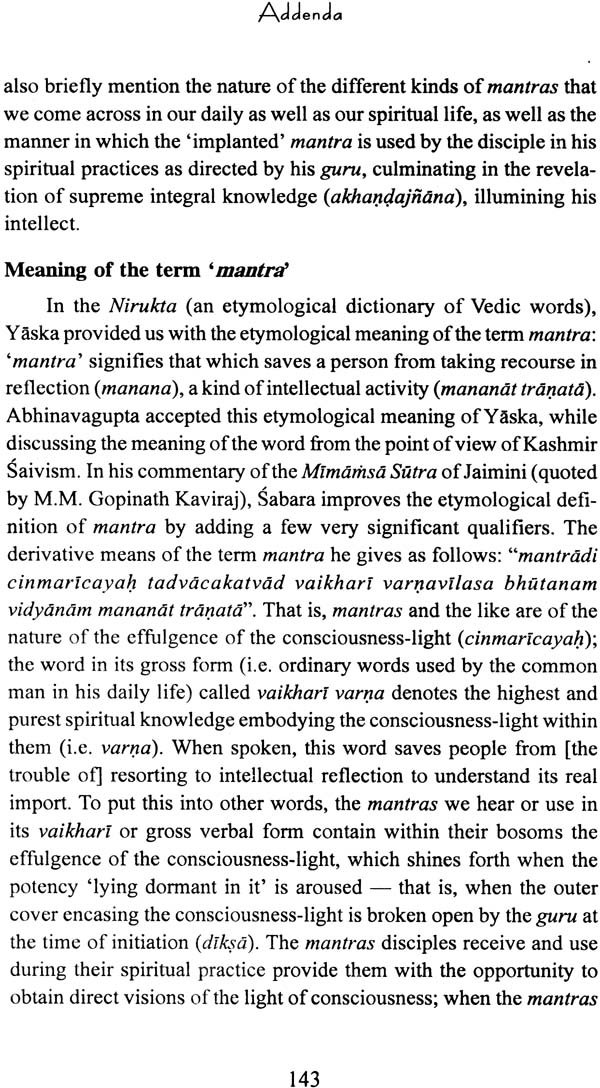
An Introduction to the Advaita Saiva Philosophy of Kashmir
Book Specification
| Item Code: | IHD004 |
| Author: | Debabrata Sen Sharma |
| Publisher: | Indica Books, Varanasi |
| Language: | English |
| Edition: | 2009 |
| ISBN: | 8186569898 |
| Pages: | 180 |
| Cover: | Paperback |
| Other Details | 8.5" X 5.5" |
| Weight | 240 gm |
Book Description
Preface
The Advaita Saiva philosophy of Kashmir, traditionally known by various names such as Trikasasana, Trikasastra, Sadardhasastra, Pratyabhijnasastra or Rahasya Sampradaya, popularly called Kashmir Shaivism, embodies the highest spiritual wisdom gleaned from the Saiva and the Saktagamas interpreted by the Advaita Saivacaryas to yield non-dualistic meaning. When I was studying some important texts in Sanskrit more than fifty years ago with the well known savant Mahamahopadhyaya Pandit Gopinath Kaviraj at Varanasi for many years for writing my Ph.D. dissertation on ‘The Philosophy of Sadhana’, I heard him many times that this spiritual philosophy represents the acme in the development of Indian spiritual thought. Very often he used to cite many parallels from the spiritual thought of other religions of the world, e.g. Coptic Christianity, the Greek Orthodox Churchm, Catholic Christianity, Sufism, Judaism, etc. to show the universal character of the Advaita Saiva spiritual thought. A few years before he left his mortal remains at Varanasi, he asked me to continue studying Advaita Saiva philosophy and disseminate its sublime thought in the world through my writings. I am following my revered Guru’s command in letter and spirit all these years. The present book represents my humble contribution in that direction.
This book is broadly divided under two parts – Book One, Historical, describing briefly the origin and development of the Saiva thought in general, and the Advaita Saiva thought in Kashmir in particular; Book Two discussing under four chapters various aspects of the metaphysical thought of this school. I have focussed my attention on those metaphysical ideas projected by the Advaita Saiva writers that appear to be novel and as innovations, and as such, marking their distinct contributions to Indian philosophical thought.
The Advaita Saivas are the staunch protagonists of the theory of integral non-dualism (akhandadvaitavada). The second chapter, entitled ‘Nature of the Supreme Reality’, opens with the examination of this particular kind of non-dualism and its implication in the metaphysical field vis-à-vis other forms of non-dualism projected by other schools of Indian philosophy. The Advaita Saivas describe the nature of the Supreme Reality one without a second, in two different ways namely, as Caitanya or Samvid as an abstract metphysical principle (nirakara tattva) as well as Parama Siva and Paramesvara possessing a form (sakara Being). The justification for their delineation of the Supreme Reality in two divergent forms side by side has been stated in this chapter. The Advaita Saiva philosophers describe the Supreme Reality as the transcendent Absolute (anuttara) and at the same time as all-pervasive Reality (Visvatmaka) – a metaphysical theory not seen elsewhere in any other school of Indian philosophy. Their integral approach in their views is reflected in their conceiving the ultimate Reality being endowed with Divine Sakti as inalienable aspect.
The theory of creation figures in the metaphysical thought projections of all schools of Indian philosophy. The Advaita Saiva philosophers have not only shed light on the process of the world manifestation in the conventional way, they have added a new dimension to it by describing it in terms of involution (avaroha) on the part of Caitanya to the gross level of matter, or as the unfoldment (unmesa) on the part of the Supreme Lord (Paramesvara) out of His free will (Svacchaya), exercising His svatantrya sakti’ or as His self extension in the aspect of His Sakti (svasaktisphara). It may be pointed out that the manifestation of the universe is universally recognized in all theistic schools of Indian philosophy as divine Play (Lila) on the par of the Godhead. While agreeing with this description in principle, the Advaita Saivas modify slightly the idea of divine Play by using the metaphor of drama (jagannataka). They describe the world manifestation as a drama enacted by Parama Siva, playing the role of Nataraja and also participating actively therein assuming different roles (bhumika) and experiencing ecstatic delight (ananda) – a fact which may also be regarded as the motivating force in His self-manifestation as the Universe. All these novel ideas relating to creation have been explained in the third chapter.
The fourth chapter discusses the mature of man, a key figure in the world manifestation, and also evaluates his status in the creation. It has been stated that embodied man is the self-contracted form of the Supreme Lord (Paramesvara) who is enveloped by the veil of maya and her progeny of five sheaths (kancukas) and enwrapped bypsycho-physical frame-work, i.e. the body caused by a defilement called karmamala. The Advaita Saiva philosophers mention seven different kinds of experients or subjects (pramata), a concept unique in the annals of Indian philosophy. The nature of these experients embodied, unembodied, and disembodied has been exposed. Light also has been shed on the theory of twofold ignorance, technically called bauddha ajnana (ignorance about the nature of the self, having its seat in the intellect) and paurusa ajnana (ignorance arising from self-contraction) and their counterparts, the paurusa jnana and the bauddha jnana. Abhinavagupta, the celebrated exponent of the Advaita Saiva thought has described the process of universal manifestation in terms of denoted (vacaka) and donoter (vacya). The denoted is represented by the thirty-six tattvas and different modes of the functioning of the divine Sakti while the denoter (vacya) is symbolized by the pulsations of the divine Sakti (spanda) underlying all tattvas, described in terms of matrka varnas, i.e. letters of the devanagari alphabet (varnamala) beginning with ‘a’ varna and ending with ‘ha’ varna. The deeper meaning of this esoteric concept and its implications can be understood when the nature of purnahamta (putre I-experience indicative of the Fullness nature of the Self) is examined. This concept has been discussed in this chapter. The nature of sahakas’ self-experience as Sivo ‘ham (I am Siva), involving this concept of purnahamta, has also been explained.
Some key concepts like the nature of citta (the ‘mirror’ of all experiences), kala (time), desa (space), all belonging to the domain of metaphysics, and prana (vital air), its origin and role in life in the mundane plane and the spiritual practices, the nature of mantra (sacred words) and its application in spiritual practices – all related to sadhana – constitute the subject matter of the concluding fifth chapter. I have included these topics in this book dealing with the philosophy of the Advaita Saiva school of Kashmir for two reasons – one, the spiritual discipline forms an integral part of the religio-philosophical thought of this school, and our knowledge of the philosophy of this school would remain incomplete if we exclude these key concepts from our exposition; two, the examination of these key concepts would enable us to highlight the contribution made by this school to enrich our ancient spiritual heritage. It may be mentioned here that generally these topics do not find place in the books on the philosophy of this school.
I must first acknowledge my debt of gratitude to the revered Swami Chidvilasananda, popularly known among her disciples as Gurumayi, for encouraging me to continue my studies in the field of Kashmir Saivism and showering her blessings on me. I am grateful to her for allowing me to dedicate this book to her as my humble offering with profound respects.
I am deeply indebted to my Guru late Mahamahopadhyaya Gopinath Kaviraj for initiating me in the study of abstruse texts on the Advaita Saiva philosophy of Kashmir and giving me insight in grasping the deep spiritual meaning encoded in them; to the late Dr. Kanti Chandra Pandey for his learned pioneering work in the field of this school; to the late revered Swami Lakshman Joo for providing with authentic and lucid exposition of subjects pertaining to sadhana.
I am grateful to all my teachers Professor Arabinda Basu and Professor Gobinda Gopal Mukhopadhyaya, the latter in particular for encouraging me to write this book and for going through the first drafts and giving me many valuable suggestions.
I express my gratefulness to Mr. Alvaro Enterria, Publications Director of Indica Books, and Mr. Michael Ianuzielo working there, for carefully going through the manuscript, editing the text and suggesting many improvements in the book. I am also indebted to Shri D.K. Jaiswal, Director of Indica Books, for kindly undertaking the publication of this book and seeing it through the press.
Last but not the least, I am also thankful to my wife Mrs. Dipika Sensharma, my daughters Alakananda and Madhucchanda and my grand-daughter Pratyusha.
I am conscious of my limitations for which I solicit apology from my readers. Despite all care, many errors in printing might have crept in for which I crave their indulgence.
Back of the Book
Ancient Indian tradition traces the origin of the Saiva cult to the Agamic thought current. The emergence of the Trika school of Saivism in Kashmir marks the climax in the development of the Advaita Saiva thought, being backed up by a rich Sanskrit literature. The doctrine of recognition (pratyabhijna) constitutes the cardinal doctrine in the philosophy of the Advaita Saiva School. The sadhaka (spiritual seeker) has to try to discover his real being by removing the various veils, to thereafter recognize his true essence.
The Advaita Saivas describe the nature of the Supreme Reality, one without a second, in two different ways namely, as Caitanyaor Samvidas an abstract metaphysical principle (nirakara tattva) as well as Parama Siva and Paramesvara possessing a form (sakara Being) They also describe the Supreme Reality as the transcendent Absolute (anuttara) and at the same time as all-pervaisive Reality (visvatmaka).
The Advaita Saiva philosophers have not only shed light on the process of the world manifestation in the conventional way, they have added a new dimension to it by describing it in terms of involution on the part of Caitanyato the gross level of matter; or as the unfoldment on the part of the Supreme Lord out of His free will, exercising His svatantrya sakti, or as His self-extension in the aspect of His Sakti. They mention seven different kinds of experients or subjects (embodied, unembodied, and disembodied), a concept unique in the annals of Indian philosophy.
The concept of purnahamta (pure I-experience) symbolizing the fullness-nature of the Supreme Experient, i.e. Siva pramata, different from the ego-experience (ahamkara) of the limited embodied being, has been explained in this book in esoteric terms as it marks a unique contribution of Kashmir Saivism to Indian philosophical thought.
Dr. Debabrata Sen Sharma, a well-known scholar of Sanskrit and Indian Philosophy and Religion, has spent more than half a century in studying, teaching and writing on the Advaita Shaiva thought of Kashmir.
| Preface | 11 | |
| | ||
| I | Origin and Development of the Advaita Saiva Thought in India | 17 |
| 1. Preliminary remarks | 17 | |
| 2. Development of Saivism as a school of religious philosophy | 20 | |
| 3. Origin and growth of the Advaita Saiva school in Kashmir | 25 | |
| | ||
| II. | Nature of the Supreme Reality | 39 |
| 1. Introductory remarks | 39 | |
| 2. Concept of non-dualism (advaita): different views | 40 | |
| 3. Nature of the supreme reality in Advaita Saiva thought | 45 | |
| 4. Nature of caitanya or consciousness – the Advaita Saiva view | 46 | |
| 5. The nature of Sakti | 51 | |
| Diagram of the Satkona | 55 | |
| III. | The Supreme Reality: Its Manifestation as the World | 59 |
| 1. Background - Identity of the supreme reality and the supreme Lord | 61 | |
| 2. The supreme Lord and His role in His self-manifestation as the world | 61 | |
| 3. Ecstatic delight: the motivating force in His self-manifestation as the world | 62 | |
| 4. The supreme Lord and His self-manifestation as the world | 64 | |
| 5. Nature of abhasa (self-manifestation as the world) | ||
| 6. Meaning of Tattva in macrocosmic and microcosmic forms, constituting the cosmos and the embodied individual | 69 | |
| 7. World-manifestation: an overview | 72 | |
| Diagram of the world manifestation showing the four andas | 75-76 | |
| 8. Nature of the thirty-six tattvas | 77 | |
| 9. Classification of the world-manifestation under the kalas; the bhuvanas contained therein | 99 | |
| Diagram of the world manifestation showing the five kalas with the bhuvanas | 100 | |
| IV. | The Nature of Man and his Status in the World-manifestation | 102 |
| 1. Introductory remarks | 102 | |
| 2. Different types of subjects (pramata) and the variable nature of their experiences | 103 | |
| 3. Advaita Saiva views of embodied human beings, their nature, different kinds of bonds and body-garb | 112 | |
| 4. Distinction between ego-experiences (ahamkara) and the pure – experience (aham) | 116 | |
| 5. Twofold ignorance and twofold knowledge (bauddha and paurusa ajnana and jnana) | 118 | |
| 6. The concept of purnahamta (the integral I-experience) and its basis and implications in Saiva thought | 120 | |
| Tables of warnas and their denoted tattvas | 123-124 | |
| Addenda | 126 | |
| Introduction to other key concepts | 126 | |
| 1. Citta in Advaita Saiva thought | 127 | |
| 2. Prana, it origin and it role in the life of embodied beings | 132 | |
| 3. Nature and role of mantra in the spiritual practices of the Tantric tradition | 142 | |
| 4. Concepts of time (kala) and space (desa) in Advaita Saiva thought | 150 | |
| 5. Nada, bindu and kala | 155 | |
| Glossary of technical terms in Sanskrit | 159 | |
| Index | 169 | |
| Selected Bibliography | 177 |
